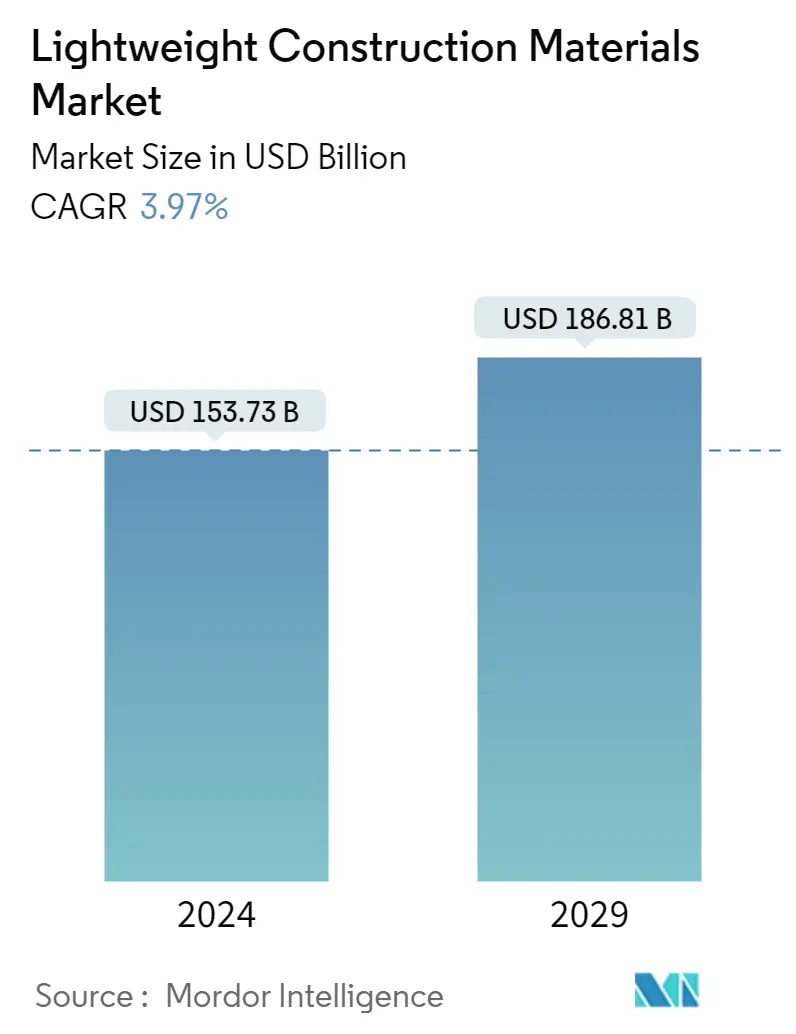Market Size of Lightweight Construction Materials Industry

| Study Period | 2019-2029 |
| Market Size (2024) | USD 153.73 Billion |
| Market Size (2029) | USD 186.81 Billion |
| CAGR (2024 - 2029) | 3.97 % |
| Fastest Growing Market | Asia Pacific |
| Largest Market | Europe |
Major Players
*Disclaimer: Major Players sorted in no particular order |
Lightweight Construction Materials Market Analysis
The Lightweight Construction Materials Market size is estimated at USD 153.73 billion in 2024, and is expected to reach USD 186.81 billion by 2029, growing at a CAGR of 3.97% during the forecast period (2024-2029).
- As the world's population becomes increasingly urbanized, there is a growing demand for high-rise buildings. Lightweight construction materials can be used to reduce the weight of these buildings, which can save on foundation costs and reduce the risk of earthquakes. For example, the North American urban population for 2022 was 308,798,139, a 0.77% increase from 2021.
- The North American urban population for 2021 was 306,441,356, a 0.44% increase from 2020. The North American urban population for 2020 was 305,103,974, a 1.22% increase from 2019. Furthermore, in 2022, the degree of urbanization worldwide was at 57 percent. North America was the region with the highest level of urbanization, with over four-fifths of the population residing in urban areas.
- Lightweight construction materials can help to improve the energy efficiency of buildings by reducing the amount of heat that is lost through the walls and roof. For instance, the value of investments in energy-efficient buildings in H1 2023 was higher in Europe than in any other region. Investments for that market in China amounted to USD 22 billion, which was somewhat lower than in the United States (USD 28 billion). These investments are necessary to reduce the environmental impact of buildings, as they were responsible for a significant share of global greenhouse gas emissions. These materials can help to reduce the environmental impact of construction by using fewer raw materials and producing less waste.
- Lightweight construction materials play a crucial role in the aerospace and defense sectors, enabling the development of highly efficient and durable structures for aircraft, spacecraft, and defense vehicles. These materials contribute to significant weight reduction, enhancing fuel efficiency, increasing payload capacity, and improving overall performance. Since 2013, a total of approximately USD 272 billion of equity investments have been made in space companies worldwide. United States space companies have accounted for almost 47 percent of the total investment, followed by China with 29 percent.
Lightweight Construction Materials Industry Segmentation
Lightweight construction materials are materials that have a low density compared to traditional construction materials, such as concrete or steel. They are typically used in applications where weight is a critical factor, such as in the construction of aircraft, automobiles, and high-rise buildings. Lightweight construction materials can also be used to improve energy efficiency and reduce construction costs.
The lightweight construction materials market is segmented by product type (bricks, wood, concrete, and others), construction type (residential construction, commercial construction, industrial construction, and infrastructure), and geography (North America, Europe, Asia-Pacific, Latin America, and Middle East & North Africa).
The report offers market size and forecast for the lightweight construction materials market in value (USD) for all the above segments.
Lightweight Construction Materials Market Size Summary
The lightweight construction materials market is poised for significant growth, driven by the increasing urbanization and the demand for energy-efficient buildings. As urban populations rise, particularly in regions like North America and Europe, the need for high-rise structures becomes more pronounced. Lightweight materials offer a solution by reducing the overall weight of buildings, which in turn lowers foundation costs and enhances seismic resistance. These materials are also crucial in improving energy efficiency by minimizing heat loss, thereby reducing the environmental impact of construction. The buildings and construction segment is a major contributor to the market's expansion, with lightweight materials being widely adopted for their cost-effectiveness and design flexibility. The market is characterized by a mix of global and regional players, with Europe expected to hold a significant share due to its stringent energy efficiency regulations and well-established manufacturing base.
In addition to the construction sector, lightweight materials play a vital role in aerospace and defense, where they contribute to weight reduction and improved performance of aircraft, spacecraft, and defense vehicles. The market's growth is further supported by the increasing popularity of off-site construction methods and the use of materials like cross-laminated timber and autoclaved aerated concrete, which offer superior thermal insulation and sustainability benefits. The market's fragmented nature sees major players like HeidelbergCement, Granite, Trinity, James Hardie, and Hanson actively participating in various initiatives to enhance sustainability and efficiency. Partnerships and projects, such as those by James Hardie and Boral Limited, highlight the ongoing efforts to integrate sustainable practices within the industry, ensuring the availability of high-quality lightweight materials at competitive prices.
Lightweight Construction Materials Market Size - Table of Contents
-
1. MARKET INSIGHTS
-
1.1 Current Market Scenario
-
1.2 Technological Trends in the Market
-
1.3 Governemnt Regulations and Initiatives in the Market
-
1.4 Insights into Supply Chain/Value Chain Analysis
-
1.5 Impact of Covid-19 Impact on the Market
-
-
2. MARKET SEGMENTATION
-
2.1 By Product Type
-
2.1.1 Wood
-
2.1.2 Brics
-
2.1.3 Concrete
-
2.1.4 Other Product Types
-
-
2.2 By Constrution Type
-
2.2.1 Resdential
-
2.2.2 Commercial
-
2.2.3 Industrial
-
2.2.4 Infrastructure
-
-
2.3 By Goegraphy
-
2.3.1 North America
-
2.3.1.1 United States
-
2.3.1.2 Canada
-
2.3.1.3 Mexico
-
-
2.3.2 Europe
-
2.3.2.1 Germany
-
2.3.2.2 France
-
2.3.2.3 United Kingdom
-
2.3.2.4 Italy
-
2.3.2.5 Spain
-
2.3.2.6 Rest of Europe
-
-
2.3.3 Asia-Pacific
-
2.3.3.1 China
-
2.3.3.2 Japan
-
2.3.3.3 India
-
2.3.3.4 ASEAN
-
2.3.3.5 Rest of APAC
-
-
2.3.4 Latin America
-
2.3.4.1 Brazil
-
2.3.4.2 Mexico
-
-
2.3.5 Middle East & Africa
-
2.3.5.1 GCC
-
2.3.5.2 South Africa
-
2.3.5.3 Rest of Middle East & Africa
-
-
-
Lightweight Construction Materials Market Size FAQs
How big is the Lightweight Construction Materials Market?
The Lightweight Construction Materials Market size is expected to reach USD 153.73 billion in 2024 and grow at a CAGR of 3.97% to reach USD 186.81 billion by 2029.
What is the current Lightweight Construction Materials Market size?
In 2024, the Lightweight Construction Materials Market size is expected to reach USD 153.73 billion.

